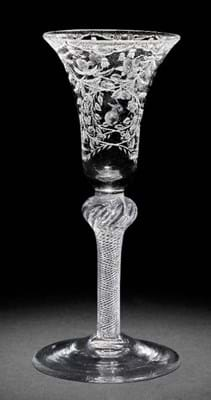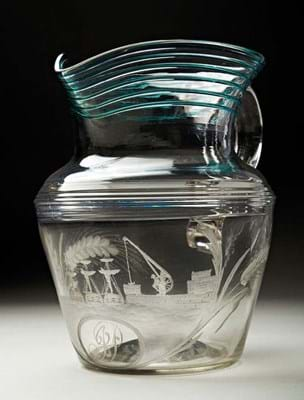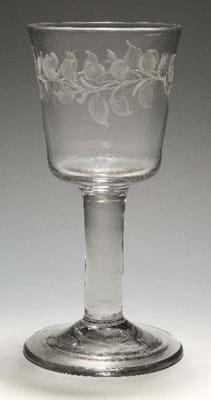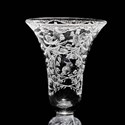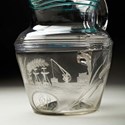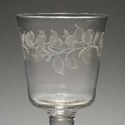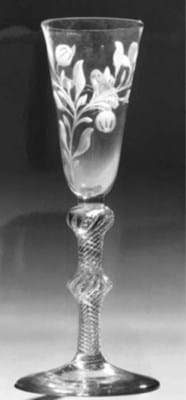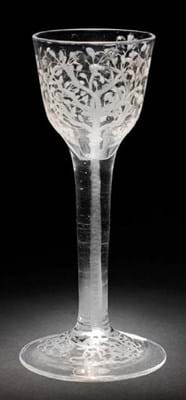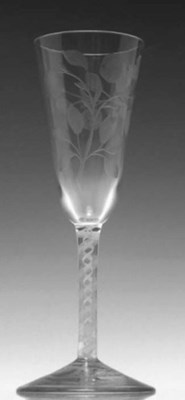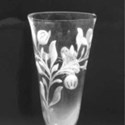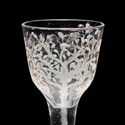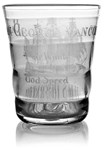ATG: How and when did you get the collecting bug?
Geoffrey Walton: It was back in the mid-1960s when I lived in Lincoln and visited the Usher Museum when my interest in Georgian glass was first stimulated.
It was also possible to buy some glasses in the local auctions in the city. At that time there were many antiques shops in and around the Lincoln area and generally more interest in antiques than there is currently.
What drew you to glassware and 18th century drinking glasses in particular?
They are things of beauty that have a fascination being made of such fragile material. The 18th century drinking glasses like those seen in the Usher Museum always caused a stir at local auctions.
Are these items effectively glasses decorated with engravings of fruit or were they used specifically and only for drinking cider and perry?
Many Georgian drinking glasses are decorated with images appropriate to the beverage to be consumed. Wine glasses typically had grapes and vine leaves, beer had barley sprays and sheaves with hops and cider and perry glasses had images of apples and pears.
How widespread was cider and perry drinking compared with beer drinking at that time?
In Georgian times drinking water was unwise unless it was drawn from deep wells away from populated and industrial areas and filtered and boiled. Little wine was produced in England so the principal beverages consumed were ale and beer.
In the late 1600s there were 1700 ale house, inns and taverns in Britain when the population was less than 4 million (one for every 230 men, women and children).
There were a few establishments that sold cider and perry, but it tended to be a localised beverage concentrated in the West Country, parts of the south coast and East Anglia where the apples and pears were grown.
Cider and perry consumption fell far behind that of beer and ale following the poisoning events at the end of the 18th century when metal contamination occurred during cider production.
Cider consumption might perhaps be roughly correlated with the number of cider glasses that I have been able to track down. The greatest number appear to have been made between 1750 and 1770.
Who were they made for and how precisely can they be dated?
Early on in the 18th century the wealthy probably had separate sets of glasses for different types of drink. We know this from discoveries in large country houses.
The 18th century is essentially the starting point of the Industrial Revolution and changes occurred regularly in the types and images on glasses just as significant changes were also being made in the manufacture of silver and other items.
Little was stationary at a time when fashion as well as industry was innovating. Cider and perry glasses can be dated only approximately unless there is a particular association regarding the details engraved on the bowl. There are no known contemporary images in paintings or engravings of cider being drunk from glasses.
Generally cider and perry glasses can only be dated to the nearest decade or so; this is done by reference to the stem of the glass. Hence baluster and balustroid stems date to the 1730s and 1740s, plain and incised stems to the next decade and air and opaque twist stems to the 1750s to 1770s. Faceted stems appear on cider and perry glasses between c1770 and the end of the century.

A large ogee bowl on a facet stem which appears to be a multipurpose glass used for several beverages including cider. The bowl is decorated with crossed ears of barley and the rim has fruits, probably including apples and grapes, all being gilded and probably from the workshop of James Giles. It has a low conical foot and may have been produced about 1770 to 1780.
One can be more precise with the glasses that refer to the Cider Tax that was threatened in the early 1760s and imposed between 1763 and 1766. The reason this was recorded on cider glasses was that the Cider Tax required inspectors to enter private houses for the first time to check on the cider manufacturing capacity. It was the origin of the phrase “every man’s home is his castle”.
Some cider glasses have images of possible Jacobite significance but that is difficult to date i.e. before, during or after 1745.
Why do these items matter and what do they tell us about the period they came from?
The images on the glasses reflect the social and commercial history of cider production and the ingenuity of the engravers.
In my book I have attempted a classification of these images and include among the groupings items such as historical events, personal and political sentiments, horticultural activities, pollinators and pests, societal images (by which I mean elaborate decoration that would have meaning to the wealthy upper middle classes) and images likely to be of interest to the growing middle class.

Walton’s book English Cider and Perry Glasses of the 18th Century is available for £25 plus £3 P&P (for UK addresses. Enquire for international rates). To buy a copy contact geoffw@dnstonhse.co.uk
These latter images show features relating to different beverages so there may be an engraved sheaf of barley, a bunch of grapes with vine leaves and also the branch of an apple tree.
Hence one set of glasses would suffice for all and any drink at the dinner table. The house would not require separate sets of glasses. They were still a rarefied item since the bulk of the population – the rural and industrial poor – could scarcely afford glass for their windows!
Where do you find items to buy?
Almost exclusively in auctions, less commonly from a few dealers. No doubt there are some that find their way onto eBay and into charity shops but I don’t have time to spend trawling round these venues nor bring and buy stalls. Relatively few antiques fairs appear to have stands with Georgian glasses.
How would you describe your collecting habit?
Highly selective and limited. There are too many other things to do in your 80s!
Are you still adding to your collection? What do you look for when considering to adding to your collection?
Yes, I do still buy items from time to time but only specialised items such as cider and perry glasses and a few ale glasses.
What is the most you have ever spent on an item for your collection?
In the high four figures; I have not yet reached five figures.
What makes some glasses from the period much more valuable than others?
As I indicate in the book, there are many more wine glasses than ale glasses and there are many more ale glasses than cider glasses, and perry glasses are exceedingly rare. I could track down only images of about 95 cider glasses and three perry glasses; there must be more. Scarcity affects price.
How has the market for these items changed over the time you have built your collection?
I remember two large baluster wine glasses sold in an auction in Lincoln for £12 in the mid-1960s. There was a lot of interest then, but it appears to have subsided significantly in the last two decades.
There are now only three auction houses having periodic auctions that include Georgian glass – Bonhams, Wooley and Wallis and Fieldings. The odd item crops up occasionally in a few other auctions but much less predictably.
Is there a notable discovery you have made that you are particularly proud of?
Yes, it’s engraved with three different fruit trees which might be apple, pear and plum. The trunks and roots are shown on the stem and foot. Tim Osborne at Delomonse thinks it may be unique.
What is the glass you don’t have in your collection that you’d love to have?
Any perry glass.
How extensive is your collection and do you ever sell items from it?
I have about 60 glasses. I have sold items, aided in the selection process by specialists who were not concerned with the sale.
How do you store and display your collection?
I have a couple of display cabinets on the wall in my study.
What aspect of collecting gives you most pleasure?
Finding an auction catalogue with an appropriate glass in it.
Do you enjoy drinking cider and perry?
Not particularly. I prefer an Islay malt whisky.
Do you use your glasses for drinking?
Not glasses from my main collection but a whisky glass from the 19th or early 20th century is less risky – unless the volume consumed is substantial.
Is there an extensive collecting community for these items?
There must be some since there is often much interested bidding for cider glasses in auctions.
Is there a related club or society that you are a member of?
I am a member of the Glass Society [formed by a merger of The Glass Association and The Glass Circle in 2019]. Its remit includes historical as well as contemporary glass. It holds meetings and visits and produces a quarterly publication, The Glass Cone.
Who are the specialists in your field that you particularly admire and why?
Collectors are as good as those who advise them.
The specialists I admire are Tim Osborne, Bob Marris and Peter Adamson, each of whom has advised me. I also appreciate the help that I get from the three auction houses that regularly sell Georgian drinking glasses.
It is also very useful that there are museums such as the Hereford Cider Museum and the Bristol City Museum that have archivists who are helpful and have items of great interest that may be inspected.
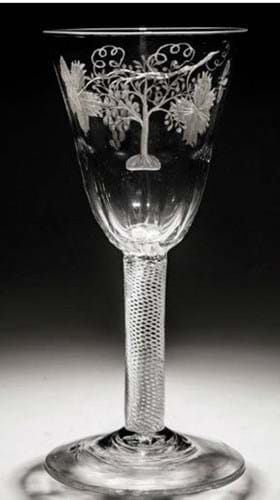
A cider glass belonging to the group of glasses also used for other beverages. The round funnel bowl is engraved with a fruiting apple tree on a square soil mound with a codling moth and a bee and on the reverse a fruiting vine with many grapes. The bowl is slightly fluted at the base and the stem is a multi-spiral air twist with a conical foot. It was possibly made some time between 1750 and 1770.
Do you also collect anything else?
Yes. Like one former Conservative cabinet minister I did not inherit my furniture and furnishings and so my wife and I have had to collect/ purchase many of the things in our house. That was both amusing, frustrating and interesting. I also collect items relevant to the books that I write.
What advice would you give a young collector?
Collect what you can afford, appreciate and use.
Why did you decide to write a book?
I am retired and have been involved in the academic and consulting worlds; report writing was not dissimilar to writing a book.
I hope the book on cider and perry glasses helps to uncover more examples of such items beyond the 100 or so that are illustrated in one place for the first time.
The book also provides a useful classification of the images on the bowls of these glasses. It may be possible to publish additional images; some have already come to light as a result of initial sales. It should be of interest to collectors, dealers, archivists and auctioneers wherever cider and perry glasses crop up.
Any more projects in the pipeline?
Yes, I am currently co-authoring a book on British Geological Sequences published in the early 19th century.



